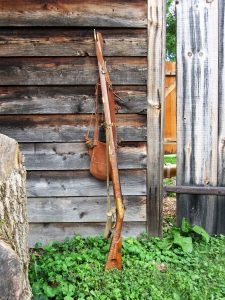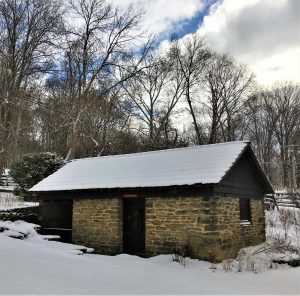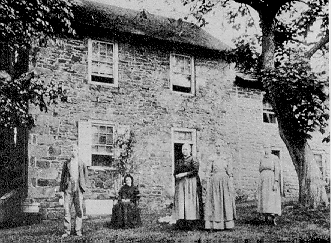The Oliver Miller Story
In 1742, young Oliver Miller emigrated with his family from County Antrim, Northern Ireland, to make a new life in America. He married Mary Tidball in Chester County, Pennsylvania, and they traveled west to Cecil Cou nty, Maryland, where he was a farmer and small scale merchant. Later they moved to Friend’s Cove near Fort Bedford, Pennsylvania, and developed another small farm to support their growing family of ten children.
nty, Maryland, where he was a farmer and small scale merchant. Later they moved to Friend’s Cove near Fort Bedford, Pennsylvania, and developed another small farm to support their growing family of ten children.
When land opened for settlement in Western Pennsylvania in 1770, the Millers with their ten children and the Tidball relatives were among the first to cross the Allegheny Mountains by packhorse to claim land.
On July 4, 1772, Oliver Miller purchased a tract of land on Catfish Run from Silas Dackster and settled on this site, later to be called Mansfield.
Trees were cleare d, crops planted, and a two-story log house with a roof of split shingles was raised. This building, being so rare, was known the country round as the “shingle-roofed house.” Due to Indian raids, the family was forced to flee several times to forts on the Monongahela River.
d, crops planted, and a two-story log house with a roof of split shingles was raised. This building, being so rare, was known the country round as the “shingle-roofed house.” Due to Indian raids, the family was forced to flee several times to forts on the Monongahela River.
From 1774 to 1780, Southwestern Pennsylvania was claimed by both the colony of Virginia and the heirs of William Penn. Oliver Miller was a man of considerable importance and was appointed Justice of the Peace of Yohogania County, Virginia, which is now part of Allegheny County, Pennsylvania. He was required to tour the land bound by the Monongahela River, Chartiers Creek, and the Ohio River to tender an oath of allegiance to Virginia to all free male inhabitants. He was also to help provide for the building of a jail and courthouse on the plantation of Andrew Heath near West Elizabeth. Click for more information: Yohogania County and The District of West Augusta
Oliver Miller died in 1782, and his will provided for the division of his land among his six sons. Most of the children had married and built homes on sections of the land. The log house was left to James, then 19, with the provision that his mother, and youngest sister, Mary, live there as well. In 1787, James married Mary Smith of Cross Creek and together they raised eight children. When the territory dispute between Virginia and Pennsylvania was settled, James applied for and received a patent, or deed, for his father’s 424 acre plantation in March 1797 under the name “Mansfield.”
The Whiskey Rebellion
An event of national importance occurred in this immediate area in 1794. An organized rebellion among the farmers broke out over the hated tax on whiskey. Federal law required that all stills be registered and that a cash tax, based on the still’s capacity, be paid prior to  producing whiskey.
producing whiskey.
Whiskey was the main money crop of the frontier farmer and about one of every six operated a still.
Whiskey was widely used for medicinal purposes, as a beverage, and as a medium of exchange. A fierce spirit of independence and an instinctive hatred of excise taxes caused many farmers to refuse to register their stills or pay the tax.
 Sons of Oliver Miller—William, John, Thomas, and James—became directly involved on July 15, 1794 when Inspector of the Revenue, General John Neville, guided United States Marshall David Lenox to the property of William Miller which was adjacent to the present day Miller Homestead. The officers attempted to serve a writ which imposed a fine of $250 for failure to register his still and required his appearance in Federal Court in Philadelphia. Since William had already sold part of his farm and made plans to move to Kentucky, he angrily refused to accept the writ. He ordered the men off his property.
Sons of Oliver Miller—William, John, Thomas, and James—became directly involved on July 15, 1794 when Inspector of the Revenue, General John Neville, guided United States Marshall David Lenox to the property of William Miller which was adjacent to the present day Miller Homestead. The officers attempted to serve a writ which imposed a fine of $250 for failure to register his still and required his appearance in Federal Court in Philadelphia. Since William had already sold part of his farm and made plans to move to Kentucky, he angrily refused to accept the writ. He ordered the men off his property.
Farmers harvesting in fields nearby heard the argument and fired several shots at the departing officers. These were the first shots fired in the Whiskey Rebellion.
News of the incident spread over the area and irate farmers marched to Bower Hill, the home of General Neville. When gunfire commenced, several of the farmers were wounded and young Oliver Miller, the son of Alexander and nephew of William Miller died of his wounds. On July 17, 1794, nearly 500 men marched to the Neville home. Angry rebels burned the barn and home of Neville to the ground. President George Washington considered this violence a serious threat to the Federal government and he ordered a force of 12,500 soldiers to quell the rebellion. William Miller, his wife and four small children left for Kentucky before the arrival of Federal troops. Thomas Miller was one of the men arrested and marched back to Philadelphia to stand trial. He was held in jail until May 1795, when he was acquitted.
Hill, the home of General Neville. When gunfire commenced, several of the farmers were wounded and young Oliver Miller, the son of Alexander and nephew of William Miller died of his wounds. On July 17, 1794, nearly 500 men marched to the Neville home. Angry rebels burned the barn and home of Neville to the ground. President George Washington considered this violence a serious threat to the Federal government and he ordered a force of 12,500 soldiers to quell the rebellion. William Miller, his wife and four small children left for Kentucky before the arrival of Federal troops. Thomas Miller was one of the men arrested and marched back to Philadelphia to stand trial. He was held in jail until May 1795, when he was acquitted.
 James Miller and many other farmers were required to sign an Oath of Allegiance to regain their rights of citizenship.
James Miller and many other farmers were required to sign an Oath of Allegiance to regain their rights of citizenship.
There were several important results of the insurrection. The coming and going of the army improved the road to the east and pumped cash into the area. Many of the soldiers settled in Western Pennsylvania after the army disbanded. People also gained confidence in the new Federal government which showed a readiness to make decisions and act with firmness.
Due in large part to the Miller family’s involvement in the events of the Whiskey Rebellion, the Stone House (although it did not exist in 1794) was put on the National Register of Historic Places in 1934.
Click here to view: Miller Family Involvement in Whiskey Rebellion
Click here to view: It All Began With a Still
Click here to view: Insurrection! A Short History of the Whiskey Rebellion
 The Stone House that exists today was built in several stages. Originally, a two-story log house stood on the site. It is believed the stone kitchen was added to the rear of this log house sometime in the late 1700’s. In 1808, using locally quarried sandstone, James Miller added a two-story addition to the log house. This addition seemed to meet the needs of the Miller
The Stone House that exists today was built in several stages. Originally, a two-story log house stood on the site. It is believed the stone kitchen was added to the rear of this log house sometime in the late 1700’s. In 1808, using locally quarried sandstone, James Miller added a two-story addition to the log house. This addition seemed to meet the needs of the Miller  family until 1830, when James’ son Oliver and new bride, Mary Wilson Miller, came to live with them. At this time the log house was replaced with the largest stone section, making it the farmhouse that stands today.
family until 1830, when James’ son Oliver and new bride, Mary Wilson Miller, came to live with them. At this time the log house was replaced with the largest stone section, making it the farmhouse that stands today.
The stone spring house on the site is also an original building. The spring is still flowing through it today.
Five generations of Millers lived on this homestead until Allegheny County purchased it and surrounding farms in 1927 to form Allegheny County’s South Park.
The Oliver Miller Homestead is owned by the Allegheny County Parks Department but operated by the Oliver Miller Homestead Associates. This all volunteer group maintains the site and its buildings. They also plan and fund the programs through a special agreement with Allegheny County.


My husband’s fourth great grandfather was Oliver Miller. His third great grandfather was William Miller. His line goes down to Michael Henry Miller through his Mother Leona Miller Jackley. We plan to visit Pennsylvania next summer and plan to attend the whiskey festival and to visit the Miller Homestead.
Sharon Jackley
In the early 1960s, my mother would take us to the spring house known as the Stone Manse. It was a lovely wading pool for young children. I visited there recently, and the spring-fed pool was dry. I often wonder why.
The springs are still in existence and barely running but yes they are there.
The place is looking lovely and the Whiskey Rebellion Day events are special.
I have live in South Park for most of my life. I graduated from the last class of Snowden High School in 1966. The township is now South Park. On one side of our class ring was the Miller Homestead. I moved away from South Park when I got a job in Pittsburgh. In 1998 my husband and I moved back to the home my father built and we took care of my mother till she passed away in 2013. I do know the reason of the much loved wading being filled in and no longer used. People would party there till all hours in the night. They would drink a lot of beer and whisky and throw the empty bottles in to the wading pools. The broken bottles in the pools were a hazard to the small children who loved the pools so the only thing they could do was fill them in so no one could get hurt. Just a week ago a cousin of mine who also was raised within walking distance to the pool was in town and she wanted to see them. She had moved away in 1957 and had fond memories of Stone Nance. I told he she would be disappointed at what has happened but sh still wanted to see it. She couldn’t belive what had happened to something that children loved so much. Kinda ironic how the Whisky Rebellion started there and whisky shut down the wonderful waiting pools with a waterfall connecting the spring filled pools.